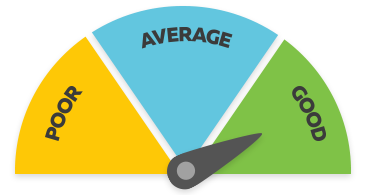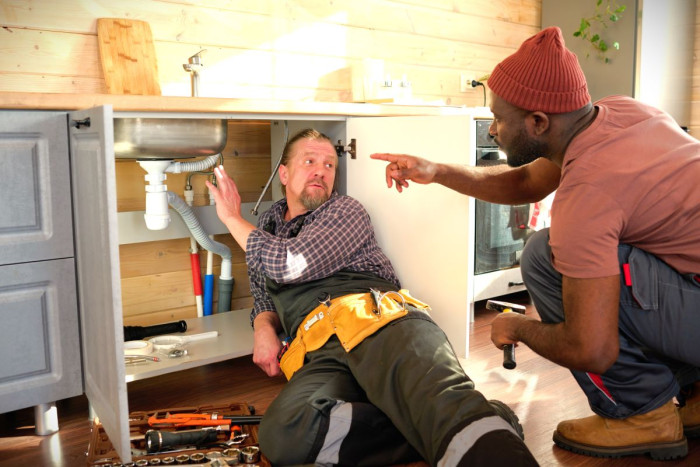Plumber, Gasfitter and Drainlayer
Kaiwhakarerewai, Kaiwhakarerekorohū, Kaiwhakatakoto Paipa Wai
Alternative titles for this job
Plumbers, gasfitters and drainlayers assemble, install and repair pipes, drains and fixtures and fittings that supply water and gas or remove waste.
Pay
Plumbers, gasfitters and drainlayers usually earn
$24-$53 per hour
Source: Seek, 2023, Southern Plumbing, Auckland Plumbers Group, 2022
Job opportunities
Pay
Pay for plumbers, gasfitters and drainlayers varies depending on experience and where you work.
- Apprentice/trainee plumbers, gasfitters and drainlayers usually start on the training or adult minimum wage and can earn up to $39 an hour as they gain skills and unit standards.
- Newly licensed plumbers, gasfitters and drainlayers usually earn $35 to $42 an hour.
- Licensed and experienced plumbers, gasfitters and drainlayers can earn between $45 and $53 an hour.
Those running their own business may earn more than this, but their income depends on the success of their business.
People specialising as drainlayers usually earn a little less than plumbers and gasfitters.
As well as their wages, plumbers, gasfitters and drainlayers may get other benefits such as tool allowances, vehicle and cell phone use and health insurance.
Source: Seek, 2023; Southern Plumbing, 2022; and Auckland Plumbers Group, 2022.
- PAYE.net.nz website - use this calculator to convert pay and salary information
- Employment New Zealand website - minimum wage rates
(This information is a guide only. Find out more about the sources of our pay information)
What you will do
Plumbers, gasfitters and drainlayers may do some or all of the following:
- measure, cut and shape pipes
- install, join and seal pipes and fittings
- install and maintain hot water and heating systems such as hot water tanks, central heating, gas heaters and heat pumps
- lay or repair drains, and get consents from local councils to do the work
- install and repair roofing pipes and spouting
- replace or repair damaged or blocked water, sewerage and gas pipes
- install fixtures such as gas stoves, toilets, basins, septic tanks and air-conditioning systems
- run their own business.
Skills and knowledge
Plumbers, gasfitters and drainlayers need to have:
- knowledge of plumbing and drainage materials and methods
- skill in interpreting designs, plans and instructions
- knowledge of building and safety regulations
- knowledge of the Building Code in relation to plumbing, gasfitting and drainage
- soldering and welding skills
- some knowledge of electrical systems.
Plumbers, gasfitters and drainlayers who are self-employed also need business skills.
Working conditions
Plumbers, gasfitters and drainlayers:
- usually work regular business hours, but may be required to work evenings and weekends, or be on call
- work in homes, offices, commercial and industrial buildings, schools, hospitals, and on building sites and farms
- may work outdoors in all weathers, and in conditions that can be dirty, messy, smelly, cold, wet, hot or confined
- travel locally to job sites.
What's the job really like?
Plumber video
Carlos Donnell-Brown talks about life as a gasfitter – 2.16 mins
So my job as a gasfitter is to connect and supply gas to a property for
residential and commercial.
The main 2 gases we work with are natural gas and LPG
- they're both used in pretty similar settings,
just supplied at different pressures. One burns a bit hotter,
one burns a bit colder. Yeah, so a usual day for me.
I try to arrive by site between the hours of, yeah, 7 and 7.30 am.
I'm usually there for most of the day.
Sometimes I'll be going to 4 or 5 jobs in a day.
Sometimes I'll be on one job for the week. What made me become a gas fitter was
I was at school one day and then a careers day kind of came through,
they set up hanging out with a gas fitter for the day.
Then I managed to ask him for a job and he gave it to me and I've been with the
same company ever since. So we're just heading off to a client of ours just
across the road from our workshop. It's just a commercial kitchen. First up,
we're going to go check the working pressure of this gas appliance here.
It's a gas deep fryer.
Why we're checking the pressures today is if it's too low,
then your appliance isn't going to work properly, it's not going to heat properly.
On the other hand,
it can also be burning too hot and actually damage the components of the
appliance. We're looking at right now,
the burner pressure 0.98 is the preferred pressure.
So to be a Certifying Gasfitter,
you first need to get your national certificate by sitting your apprenticeship,
and then after that you set your registration exam and then you have to wait
another 2 years and that's when you become a Certifying Gasfitter. The great
thing about the apprenticeship is that the whole time you are getting paid to do
it. Knowing now I probably would've paid a bit more attention in math class and
things like that,
but all this stuff can easily be relearned on the courses we take. It's coming
out slightly higher than is suggested on the rating plate.
So how we adjust that to lower it,
adjust that in slightly to 0.98,
which is the ideal pressure for the appliance:
getting pretty close now. My favorite thing about my job is the
practical parts of it is where I thrive and where I'm on the tools doing the
stuff.
Entry requirements
To become a plumber, gasfitter or drainlayer, you need to:
- complete an apprenticeship and gain a New Zealand Certificate (Level 4) in Plumbing Gasfitting or Drainlaying
- be registered with the Plumbers, Gasfitters and Drainlayers Board.
A driver's licence is also useful.
ATT and Masterlink employ, train and place apprentices.
- ATT website - plumbing, gasfitting and drainlaying apprenticeships
- Masterlink website - plumbing, gasfitting and drainlaying apprenticeships
Industry Connection for Excellence (ICE) and Te Pūkenga oversee plumber, gasfitter and drainlayer apprenticeships.
- ICE website - plumbing, gasfitting and drainlaying apprenticeships
- Te Pūkenga website - plumbing, gasfitting and drainlaying apprenticeships
- More information about apprenticeships
Secondary education
No specific secondary education is required for this job, but English, maths, physics, design and visual communication, and construction and mechanical technologies to at least NCEA Level 2 are useful.
Year 11 and 12 learners can find out more about the construction industry and gain relevant skills by doing a National Certificate in Building, Construction and Allied Trades (Levels 1 and 2) through the BConstructive programme.
For Year 11 to 13 learners, trades academies and the STAR and Gateway programmes are good ways to gain relevant experience and skills.
These programmes may help you gain an apprenticeship, but do not reduce the amount of time it takes to complete it.
Personal requirements
Plumbers, gasfitters and drainlayers need to be:
- patient and accurate, with an eye for detail
- safety-conscious
- skilled in using and caring for equipment
- good communicators
- organised, able to follow instructions and skilled at problem-solving
- able to work independently or in a team.
Useful experience
Useful experience for plumbers, gasfitters and drainlayers includes:
- work as a drainlayer's assistant
- work in the building or heating and ventilation industries
- welding and sheet metal work
- work as a boiler maker.
Physical requirements
Plumbers, gasfitters and drainlayers need to be fit, healthy and reasonably strong, as some lifting is involved. They need to be comfortable working at heights or in small confined spaces.
Registration
Plumbers, gasfitters and drainlayers must be registered with the Plumbers, Gasfitters and Drainlayers Board and hold a practising licence.
Find out more about training
- ATT
- 0800 187 878 - www.att.org.nz
- Masterlink
- 0800 502 102 - www.masterlink.co.nz
- Plumbers, Gasfitters and Drainlayers Board
- 0800 743 262 - registrar@pgdb.co.nz - www.pgdb.co.nz
- Industry Connection for Excellence (ICE)
- 0508 442 395 - support@icexl.co.nz - https://icexl.co.nz
- Te Pūkenga
- 0800 327 648 (0800 EARN IT) - https://earnlearn-tepukenga.ac.nz
What are the chances of getting a job?
Strong demand for plumbers, gasfitters and drainlayers
Opportunities for plumbers, gasfitters and drainlayers are good due to:
- a lack of apprentices training in these areas
- moderate growth in construction predicted to extend until at least the end of 2023, meaning more building work
- the Government’s KiwiBuild programme, involving the building of quality affordable homes over the next decade
- building work needed to upgrade leaky homes and earthquake-prone buildings.
The Christchurch post-earthquake rebuild is ongoing but most of the remaining work is in the non-residential (commercial) sector.
According to the Census, 12,444 plumbers, gasfitters and drainlayers worked in New Zealand in 2018.
Increase your chances of getting an apprenticeship
Many plumbing businesses are small and often busy so they can't always take on and train apprentices. You can increase your chances of getting a plumbing, gasfitting and drainlaying apprenticeship if you have:
- a good attitude to work, good time management skills, and are willing to learn
- completed a Gateway or pre-trade programme
- experience in plumbing, gasfitting and drainlaying
- a tertiary qualification but want to retrain in plumbing, gasfitting and drainlaying.
Plumbers and drainlayers in shortage
Although over 8,000 people work as plumbers, gasfitters and drainlayers in New Zealand, there are not enough to meet demand.
As a result, plumber, drainlayer and roof plumber appear on Immigration New Zealand's construction and infrastructure skill shortage list. Roof plumber also appears on Immigration New Zealand's regional skill shortage list. This means the Government is actively encouraging skilled plumbers and drainlayers from overseas to work in New Zealand.
Most plumbers and gasfitters run their own business
About 90% of plumbers and gasfitters are self-employed or work for small companies with up to five employees.
However, only about half of drainlayers are self-employed. Others work for small to medium-sized businesses that employ between one and 20 staff.
Sources
- Immigration New Zealand, 'Construction and Infrastructure Skill Shortage List', 27 May 2019, (www.immigration.govt.nz).
- Immigration New Zealand, 'Regional Skill Shortage List', 27 May 2019, (www.immigration.govt.nz).
- Jenkins, K, operations manager, Masterlink, Careers Directorate – Tertiary Education Commission interview, May 2016.
- Ministry of Business, Innovation and Employment, 'Future Demand for Construction Workers', July 2017, (www.mbie.govt.nz).
- Mitchell, P, 'Industry Experts Expect Plumber Shortage as Demand Soars', 9 May 2016, (www.stuff.co.nz).
- Stats NZ, '2018 Census Data', 2019.
(This information is a guide only. Find out more about the sources of our job opportunities information)
Progression and specialisations
Plumbers, gasfitters and drainlayers may progress to become certifying plumbers, gasfitters and drainlayers, who can set up their own businesses and train apprentices.
They may also move into design, consultancy or teaching work in the industry.
Last updated 25 March 2025


